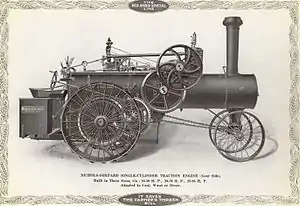Nichols and Shepard
Nichols and Shepard Co. was an American partnership company which manufactured farm machinery, steam engines and mill machinery.

.jpg.webp)
In 1848, John Nichols opened a blacksmith shop in Battle Creek, Michigan.[1] In the blacksmith shop, John Nichols began making various farm tools for local farmers. He built his first thresher/separator in 1852.[1] The business was successful from the start, so successful that some time in the 1850s he took on a partner by the name of David Shepard.[1] Together they formed a partnership known as Nichols, Shepard and Company which manufactured farm machinery, steam engines and mill machinery.[2] The first thresher/separator of small grains (largely wheat and oats) was developed in about 1831 by the Pitts brothers—Hiram and John Pitts of Buffalo, New York.[3] However, this early thresher, called the "ground hog," was quite unlike the conventional thresher/separators that developed since that time. For instance, the ground hog's separating unit was largely a slatted apron which pulled the grain across a screen.[2] John Nichols and David Shepard realized that the apron style separator was not a technology that was going to work. Consequently, in 1857, the Nichols and Shepard Company developed the first "vibrator" separating unit for the small grain thresher.[2] This vibrator-style of separator soon became universally adopted by all other thresher/separator manufacturers. The Nichols and Shepard Company received a patent from the United States government for their "Vibrator" grain separator on January 7, 1862.[2] The company also obtained a number of other patents for other advances in the thresher/separator technology, for original improvements in steam engine traction technology.[2] During the 1920s, the Nichols and Shepard Company developed a successfully functioning corn picker. In 1929 the Nichols and Shepard Company was acquired by the Oliver Farm Equipment Company. This corn picker became the direct ancestor of the famous Oliver cornpicker.[4]
See also
References
| Wikimedia Commons has media related to Nichols & Shepard Company. |
- Robert N. Pripps and Andrew Morland, Oliver Tractors (Motorbooks International: Osceola, Wisc., 1994) p. 34.
- C.H. Wendel, Oliver/Hart-Parr (Motorbooks International: Osceola, Wisc., 1994) pp. 92-93.
- C.H. Wendel, American Farm Implements & Antiques (Krause Publications: Iola, Wisc., 2004) p. 403.
- Oliver/Hart-Parr, p. 143.